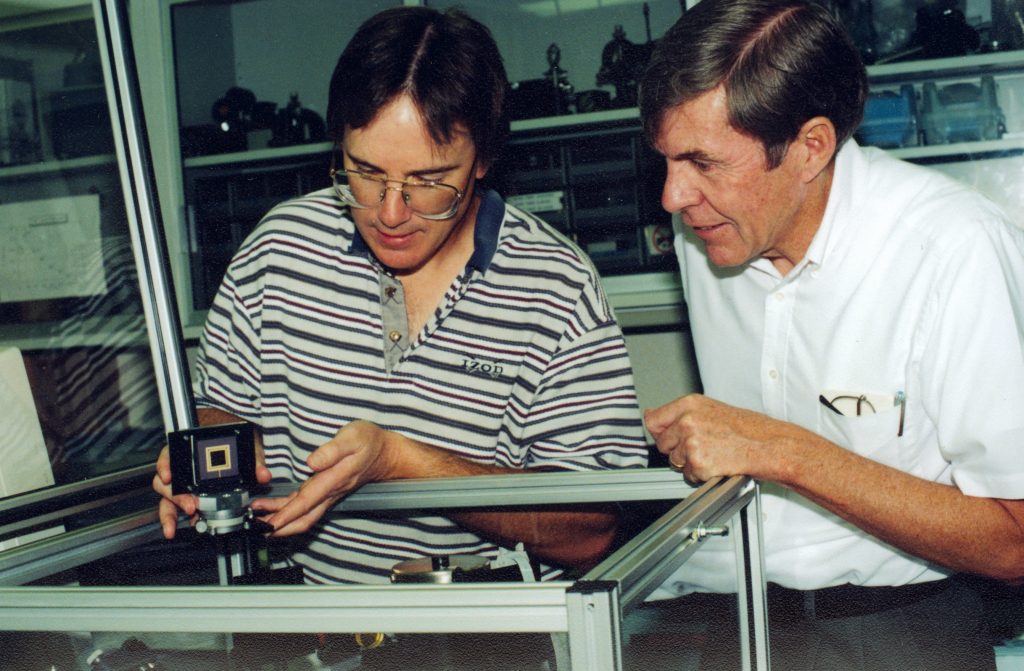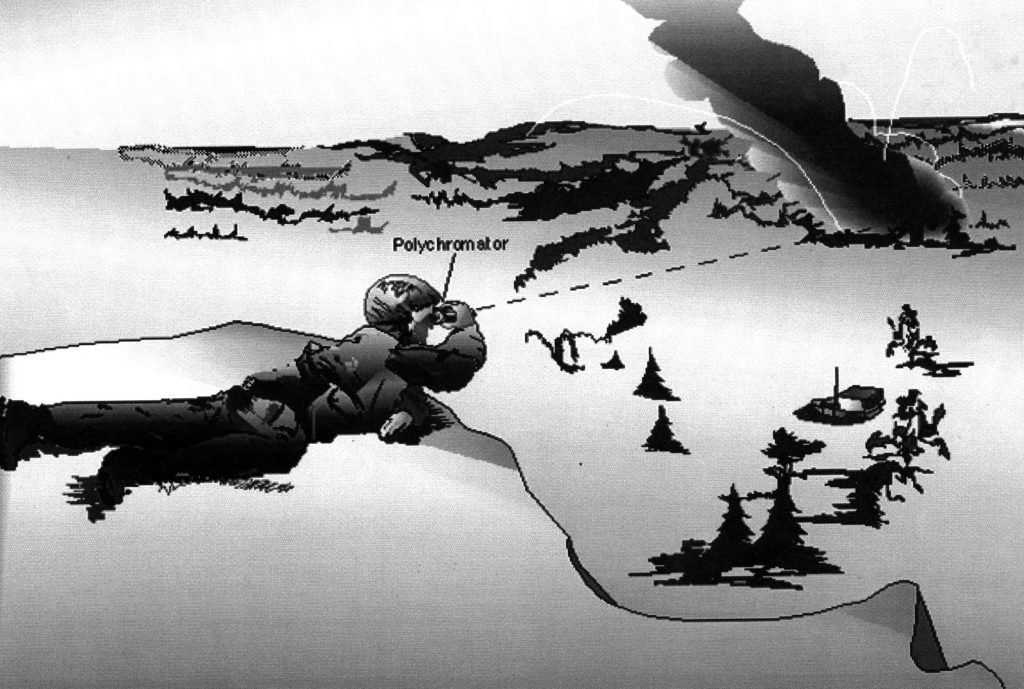
Download 300dpi JPEG image, ‘sensor1.jpg’, 1.1Mb (Media are welcome to download/publish this image with related news stories.)
ALBUQUERQUE, NM — A new remote sensor the size of a dime being developed by the Department of Energy’s Sandia National Laboratories should allow users to rapidly detect dangerous gases from up to two miles away.
Called Polychromator, the device will use a combination of optics and microelectromechanical systems (MEMS) to determine gas types. It is joint effort of Honeywell, Massachusetts Institute of Technology (MIT), and Sandia. MIT is designing the MEMS structures that are being fabricated by Honeywell.
“Imagine a soldier on a battlefield looking through a pair of binoculars with the Polychromator chip built into it and detecting from afar the nature of gas being emitted in a smoke cloud,” says Sandia researcher Mike Butler, one of Polychromator’s inventors. “There’s no need to obtain a sample of the gas or even get close to it. Instead, the detection is made from a safe one or two miles away.”
He adds, “It promises that in a matter of seconds you can tell the nature of a gas and whether it’s toxic without having an actual sample. It has all kinds of possibilities.”
Butler, together with Mike Sinclair, also a Sandia researcher; former Sandian Tony Ricco; and MIT professor Steve Senturia, have obtained two patents on the device, the most recent one in May. The researchers expect to have a functioning prototype by 2001, the end of a four-and-a-half-year funding period for the project by the Defense Advanced Research Projects Agency (DARPA).
The Polychromator is a variation of a conventional gas analysis technique, correlation spectroscopy. Infrared radiation is passed through a sample gas that imparts a spectral pattern to the radiation. This pattern is then correlated with the spectrum of a reference gas to provide the identification. Each gas has its own distinct spectral pattern, which can be used to identify the gas.
Butler says the limitation of the standard method is that it requires a reference cell of the gas and the testing equipment is bulky.
The Polychromator chip, however, is small — about the size of a dime — and does not need a reference cell. It consists of thousands of microscopic MEMS grating elements on a silicon wafer manufactured with standard microlithographic “mask and etch” techniques. Each element is 10 microns wide and one centimeter long, looks like a long flat beam, and is designed to move up and down. Light from the gas cloud shines on the chip after being collected by an optical device, such as a telescope or binoculars.

The way this would actually work, Butler says, is that as a soldier or other user peers through the binoculars and the light strikes the Polychromator chip, a microprocessor inside would direct the MEMS grating through a series of movements in a matter of seconds. Each movement would result in a different grating designed to detect a specific gas. When the grating matches and identifies the gas, the device would alert the soldier.
One of the developments making the Polychromator possible was a computer program created by Sinclair to design the gratings. He came up with the program in 1994 shortly after he and the other future patent holders began talking about the possibility of combining a hologram with a spectrometer to remotely analyze gas clouds. Senturia, the MIT professor, was a Sandia consultant at the time.
“The infrared spectra of various gases have been known for years,” Sinclair says. “My computer program uses these known spectra to calculate the grating profiles for each of the gases.”
Another computer program then uses these grating profiles to control the movement of the MEMS grating elements. So far, Sinclair has generated grating profiles for about 10 gases, but more are on the way.
While the team is still perfecting the movable MEMS grating, they already have completed silicon wafers containing fixed gratings. Sandia’s Compound Semiconductor Research Laboratory fabricated the fixed gratings that can detect 10 different gases, mostly those used in chemical warfare. Unlike the Polychromator, these gratings don’t move.
Sinclair notes that remote chemical sensors are nothing new — some have even been developed at Sandia in the past. This sensor, however, promises to have several unique characteristics.
“Unlike conventional spectrometers the Polychromator will do a lot of the spectral processing up front, making it work faster that other types,” Sinclair says. “In addition, it will be very sensitive and selective — able to discern quickly chemicals that have similar infrared spectra.”
The researchers are already on the road to a functioning Polychromator prototype. They have an optics package in-hand and are waiting on the production of a refined prototype chip from Honeywell and electronics that are being built by an outside contractor. Both are expected in the next few months.
“All we’ll have to do then is integrate everything, test, and see how well it works,” Sinclair says.